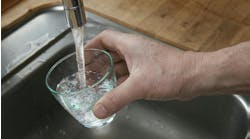At the end of last month's column (November, p. 40), I promised that we would look at the bottom line results of retrofitting variable speed pumps on a sample project.
As I explained previously, for the purposes of this column I am using an existing apartment complex for which I actually have blueprints and mechanical engineering drawings.
I went through the iterations of performing worst-case scenario heat loss calculations only to determine that the physical plant was severely oversized. The forced air convectors were typically two times larger than need be at design condition (0°F outside air temperatures). In my effort to determine the proper size of the variable speed pump, I also had to go through the iterations of flow calculations and main and branch pipe sizing. Based upon that survey, I determined my actual design load flow parameters to be 245 GPM at 26 ft. of head. Based on this existing system in the field, it would appear there is a substantial amount of energy being wasted on this project both electrically and thermally.
The system circulators consist of three 7.5-HP pumps each. These three pumps are all enabled at outside air temperatures below 65°F. Based on my field calculations, one pump is actually more pump than is required to satisfy this building's needs, even at design conditions outside.
This is quite typical of the larger multi-family residential jobs that I come across in the field, and it is an excellent candidate for the installation of variable speed circulators. My good friend and supplier Charles Potter, of Water Systems Inc., found the original pump performance curve for me in his archives. When I plotted the newly recalculated system performance curve against the pump manufacturer's performance curve, the pump performance curve was completely off the chart and below the chart's lower right hand side. I actually had to extrapolate the manufacturer's curve in order to get an intercept. At this point of the chart, one pump would be capable of moving 350 GPM at 40 ft. of head. Remember, this is at design condition.
When the pumps are first started at around 62°F outside air temperature, the actual flow demand is nearly nil, and the pump is capable of generating 58 ft. of head or 25 PSI of differential pressure.
The methodology of control at the points of use is a conventional two-way, 24Vt, spring return, normally closed zone valve with a maximum close off capacity of 6.5 PSI or approximately 15 ft. of head. As I previously stated, this system has no actual pressure activated bypasses within the system, and all of the pump head has to be dissipated somewhere or there would be exploding pumps in the mechanical room. So, I've surmised that the zone valves are acting as the pressure-activated bypasses within the building.
This results in more problems than just overheated building cores. It also causes excess wear and tear on the piping distribution systems from thermal expansion, noise generated from pipe creep and eventual erosion of the valve seat in those valves closest to the pump station. A person could alleviate this bypass condition by installing numerous paralleled pressure activated bypasses around the pumping stations. However, that is akin to leaving the engine on an automobile running at full throttle and slipping the clutch to modulate the vehicle's speed. That is simply not a wise use of energy.
By retrofitting this system with a Wilo Stratos pump, I can program the circulator to maintain a constant differential pressure, a variable differential or a fixed differential temperature mode. My first inclination is to go with the temperature differential mode and see how the system reacts. If there are any issues with this mode of operation, I can always reprogram the pump to operate at a pressure differential variable and set the head to be just below the relief threshold of the zone valves. This will ensure I have good flow throughout the system regardless of where the location is in relation to the pump station. The electrical savings alone will be on the order of $2,000 per year. There also will be a substantial reduction in natural gas consumption, although I'm not certain what it will be. But the increase in overall comfort is priceless.
The bottom line is this: The potential for significant reductions in energy consumption, both thermal and electrical, coupled with the increase in human comfort and a reduction in wear and tear on the system components warrants investigation into this burgeoning new technology. Modulation is the ultimate key to this wonderful technology.
With this being my last column of the year, I'd like to take a moment to thank all of those people who are spread out all over the world in our armed forces and guaranteeing our freedoms. I'd also like to thank their families for allowing these people to do the wonderful job they are doing. And I'd like to say Merry Christmas to my Christian friends, Happy Chanukah to my Jewish friends and Happy Holiday Hydronicing to everyone.
Mark Eatherton is a Denver-based hydronics contractor. He can be reached via e-mail at [email protected] or by phone at 303/778-7772.

